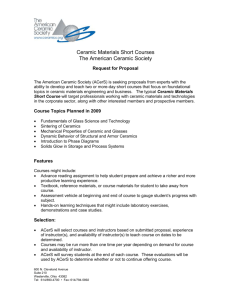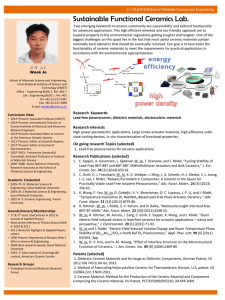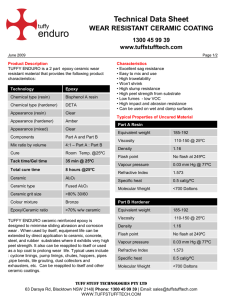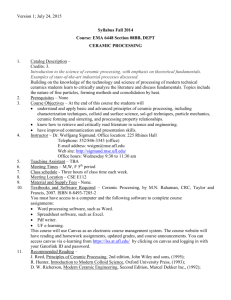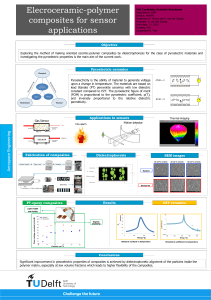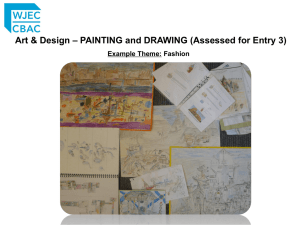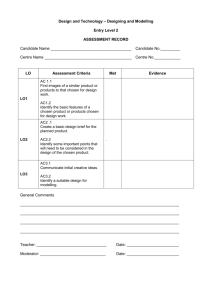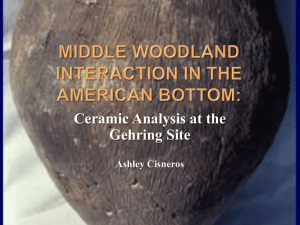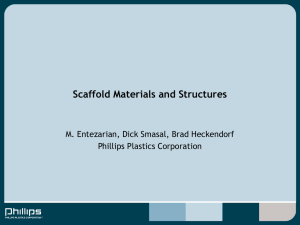Art & Design – CERAMICS (Assessed for Entry 3)
advertisement
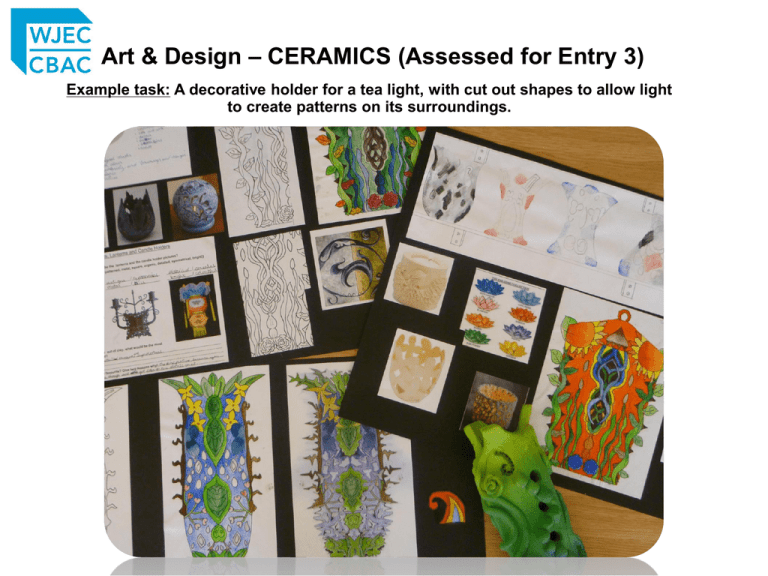
Art & Design – CERAMICS (Assessed for Entry 3) Example task: A decorative holder for a tea light, with cut out shapes to allow light to create patterns on its surroundings. AC1.1 Select a range of references and resources to support ceramic work. This AC is well covered by accessing a range of different references from a variety of cultures and styles. Many of these refer to lights and lanterns. AC1.2 Produce visual and / or tactile records of observations and experiences relating to a task or theme. This area could be covered more thoroughly. Whilst there is ample evidence of information gathered from the internet (AC1.1) There is only limited evidence of the pupil’s own visual or tactile observations. This could have been achieved using sketch/notebooks, photography and appropriate 3D modelling. AC1.3 Identify the influence of artists, craftspersons and / or designers on their own practice. Evidence of this can be seen throughout the work, which clearly demonstrates the influence of the Celtic Art and Art Nouveau references. AC2.1 Select and handle materials, tools and techniques appropriate to ceramics. This is an area that needs attention. There is too much evidence of graphic skills and not enough evidence of materials, tools and techniques appropriate to ceramics. This might have included evidence of the pupil experimenting with different ceramic construction methods, mark making in clay and examples of decorative finishes. Some of the evidence for the above could have been identified during the making process and recorded by means of photographs. AC2.2 Use visual elements in practical work, such as: colour; pattern; texture; line; shape; form; space; tone. The amplification of content within the specification suggests that form, space, pattern, texture and colour lend themselves to this area of study. In this particular unit of work form, space and texture could have been more fully explored if the emphasis had been on ceramic processes. AC2.3 Develop ideas for a ceramic outcome, modifying work as needed. Clear evidence of development of ideas; in shape, surface pattern and decoration. AC3.1 Use ceramic processes to produce an outcome in response to a task or theme AC3.2 Present a resolved ceramics outcome with some consideration of refinement. Slabbing and coiling techniques, and good surface decoration have been combined to produce a refined finished piece in response to the task set. General Comments This ceramics unit contains a lot of very high quality work and clearly the pupil is more than capable of achieving an Entry 3. However, as the work stands it would be difficult for it to fulfil all the criteria of the new Entry Pathways specification. The main concerns have already been highlighted as AC1.2, AC2.1 and to a lesser extent AC2.2. To fulfil the criteria would require, not more work but, a change of emphasis. The amplification of content within the specification states that: “Although other materials, tools and techniques will be used during the course, particularly during research, the emphasis should be on ceramic processes”. In this particular unit much of the graphic development could be replaced with ceramic based ideas. Art & Design – Ceramics (assessed for Entry 3) Example theme: Faces AC1.1 Select a range of references and resources The pupil has selected a good range of appropriate references for the work undertaken including Venetian masks, Cubism and Chinese pinch pots. AC1.2 Produce visual and / or tactile records of o relating to a task or theme. There is ample evidence of the pupil's own visual and written observations. However, the use of simple ceramic materials or even plastercine for some of the work would have enhanced this area of investigation. AC1.3 Identify the influence of artists, craftsperso practice. This example clearly shows the influence of Picasso's cubist style on preparatory work and on the final outcome. AC2.1 Select and handle materials, tools and tech AC2.2 Use visual elements in practical work, such line The pupil has gained experience using two dimensional materials, tools and techniques, as well as using a number of the visual elements throughout the course. However, those techniques specific to ceramics, such as slabbing, carving, moulding, etc., as well as the visual elements of shape, form and space, which are particularly important for this area of study, are only evident in the three final outcomes. AC2.3 Develop ideas for a ceramic outcome, mo There is evidence of development and modification of ideas. However, once again the use of ceramic processes during the development of ideas would have enhanced the work, and probably benefited the outcomes. AC3.1 Use ceramic processes to produce an outco AC3.2 Present a resolved ceramics outcome with s The pupil has produced three separate ceramic outcomes in response to the chosen theme. Each of them displays a degree of refinement. General Comments An ambitious unit of work covering three separate topics within the theme of 'Faces' - Venetian carnival masks, Picasso's Cubist portraits and Chinese pinch pots. The pupil has collected good references and has obviously benefited from a variety of art experiences whilst developing ideas for the three successful outcomes. However, the amplification of content within the specification states that “Although other materials, tools and techniques will be used during the course, particularly during research, the emphasis should be on ceramic processes”. Even though a variety of ceramic processes have been used to produce the final outcomes, there is a lack of ceramic experiences as the work has progressed. As already noted the main areas of concern are AC1.2, AC2.1, AC2.2 and AC2.3. With more emphasis on ceramic processes and perhaps less work in other areas where evidence has been duplicated, this would be a strong Entry 3.
